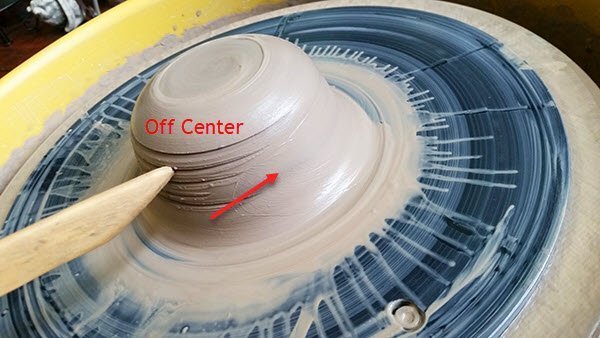Learning How to Centre Clay on The Wheel is a Challenging, Yet Crucial Skill
Centring clay on the pottery wheel is one of those things that looks incredibly easy to someone who has never tried it. If you are new to pottery, you will quickly find out that it is not as intuitive as it first looks. However, once you learn the skill, it’s like riding a bike.

Ultimately, centring clay just takes some perseverance. It will be highly frustrating at times, but you just need to keep practicing. At some point, you will have an ‘ah-ha!’ moment and it will suddenly click.
The more you do it, the faster you will be able to centre clay, which will be important if you plan on making lots of pieces in a limited timeframe.
Although it ultimately comes down to practice and patience, you need to make sure that you have the basic techniques and practices in check. This article will guide you though some of the common issues that trip people up when it comes to centering clay on a pottery wheel.
It is difficult get across the dynamic techniques through a written article. For this reason, we recommend you watch the following video so that you can see the hand positions and movements in action.
How to Center Clay — A Beginner's Guide - YouTube
It is also highly recommended that you are taught the basics at a pottery studio. This is where most people start, so we will assume that you have at least had some introductory lessons.
10 Tips to Combat Some of the Common Beginner Issues with Centering Clay on the Wheel.
Tip 1: Pick the right clay
When learning how to throw, you need to put all factors in your favour. One big factor in how easy learning to center clay is, is the type of clay. Some clay is more suited to hand-building than throwing.
The best clay to use is one that is fairly smooth and malleable. Although, it is good choose a clay with a little bit of grog or sand in it, because this makes it slower to centre and therefore more forgiving and less likely to collapse.
White St Thomas clay is great for beginners. It is also very low priced, so you won’t have to worry as much about wasting bits of it.

Tip 2: Keep your arms anchored
Many people naturally raise their arms up without realising when they are focusing hard on centring the clay on the wheel. Keeping your arms low and anchored to your body or legs is really useful when it comes to having the strength and stability to manipulate the clay effectively.

Tip 3: Properly Wedge your clay
Wedging clay is a skill in itself. It can be tempting to rush this or even skip it completely. However, this is going to significantly increase your chances of running into problems when centering clay.
Ineffective wedging means that you end up with inconsistencies in your clay; some parts will be harder than others, and moisture will be distributed inconsistently.
This can also lead to air pockets in your clay, which can sometimes make centring almost impossible.

Tip 4: Use the right amount of water
Using too little or too much water can cause issues when centring:
Too little water:
The clay should feel moist and should smoothly move across your skin. If it feels too dry, you can always add more water, but you should add it slowly. The best way to do this is to dip your hands in water and continue centring. Alternatively, to avoid taking both hands off the wheel, you can dip a sponge into the water with one hand and gently squeeze out some water onto the clay.
Too much water:
Clay can sometimes get too wet if you are new to throwing and are struggling to centre it. Drying clay is a little bit harder than getting it wet. You can try to get some of the water out by wedging. Failing this, you can lay your clay out to dry and get started with a fresh piece.
This will happen time to time, so don’t be disheartened.
Another thing to make sure of is that you should start with a dry wheel head/bat. This will ensure that the clay does not slide around too much.
Tip 5: Keep a high wheel speed
Some beginners are tempted to go slowly with the wheel to start with. Although it may sound counterintuitive, a higher speed will actually make the process easier. The clay will take a shorter time to make a full revolution, meaning that you have to hold your hand in position for less time to get a rounded shape.
Tip 6: Start with a regular shape
This is a small tip, but goes a long way. Make sure that the shape that you start with is regular and round. Otherwise, you will find it much harder to centre.

Tip 7: Keep you hands in a firm but relaxed state
You must find the optimum amount of pressure to apply to the wheel. Some beginners are too rigid and tense when they learn throwing, while others let their hands go too floppy and weak. Your hands must be firm but also move smoothly and slowly.
Tip 8: Remove your hands slowly
Sometimes you have to resist the urge to quickly take your hands off the wheel to celebrate when you think you have successfully centred. This can often result in the clay becoming off centre again.
Make sure that you slowly and gently remove your hands, and this shouldn’t be a problem.
Tip 9: Knowing when your clay is centered:
Sometimes it can be hard to tell whether clay is completely centred. We have a hack that can help with this.
Grab a modelling tool and place it against your clay. Hold it tight and then slowly turn the wheel. If the clay is completely centred, then the tool will make a line all the way around the clay.
If the clay is not centred, then the line will only be on one side of the clay.

Tip 10: DO NOT GIVE UP!
By far the most important tip. Learning to throw can be an incredibly frustrating task at times, partly because of how deceivingly easy some people make it look. Just know that these people all started exactly where you are. Almost everyone finds it difficult to start with so you are not alone.
Having your own potters wheel can really help with this, as sometimes you just need to be left alone to try it over and over again without feeling any pressure. We recommend that you at least have a few lessons first though, to make sure that pottery is actually something you’d like to pursue long-term.
Good luck and happy potting!
The Pottery People
Get someone who knows what they are doing to check your form and then just keep practicing. Soon it will feel like second nature to you and you won’t even have to think about it.

